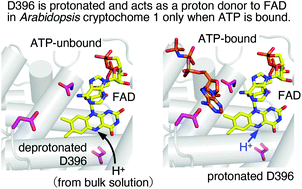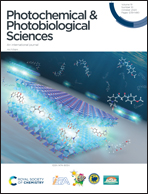ATP binding promotes light-induced structural changes to the protein moiety of Arabidopsis cryptochrome 1†
Abstract
Cryptochromes (CRYs) are blue-light receptors involved in photomorphogenesis in plants. Flavin adenine dinucleotide (FAD) is one of the chromophores of cryptochromes; its resting state oxidized form is converted into a signalling state neutral semiquionod radical (FADH˙) form. Studies have shown that cryptochrome 1 from Arabidopsis thaliana (AtCRY1) can bind ATP at its photolyase homology region (PHR), resulting in accumulation of FADH˙ form. This study used light-induced difference Fourier transform infrared spectroscopy to investigate how ATP influences structural changes in AtCRY1-PHR during the photoreaction. In the presence of ATP, there were large changes in the signals from the protein backbone compared with in the absence of ATP. The deprotonation of a carboxylic acid was observed only in the presence of ATP; this was assigned as aspartic acid (Asp) 396 through measurement of Asp to glutamic acid mutants. This corresponds to the protonation state of Asp396 estimated from the reported pKa values of Asp396; that is, the side chain of Asp396 is deprotonated and protonated for the ATP-free and -bound forms, respectively, in our experimental condition at pH8. Therefore, Asp396 acts a proton donor to FAD when it is ptotonated. It was indicated that the protonation/deprotination process of Asp396 is correlated with the accunumulation of FADH˙ and protein conformational changes.

- This article is part of the themed collection: Photofunctional flavoproteins and UVB photosensors


 Please wait while we load your content...
Please wait while we load your content...